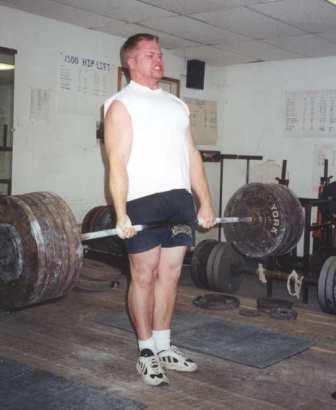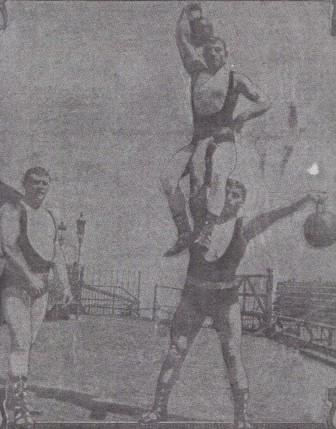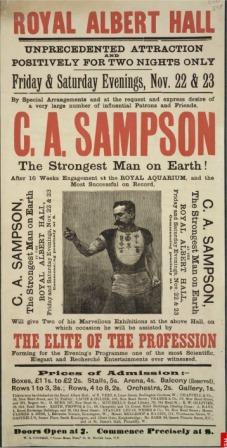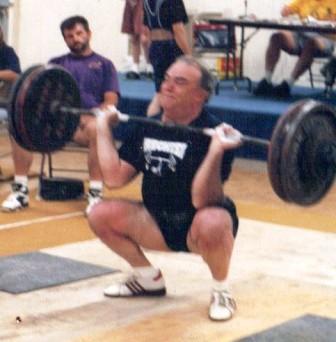Taking Care of Your Back – Part 1
by Al Myers

Mike McBride, the Best Lifter at the 2005 USAWA National Championships, performing a Deadlift with Heels Together with over 600 pounds. This All-Round variation of the deadlift increases the stress placed upon the back compared to a traditional deadlift.
Recently, I was contacted by an all-round lifter who asked my advice in dealing with persistent back pain caused from his training. I’m not going to give his name out here, but he is one of the strongest current All-Rounders in the World and is capable of deadlifting over 700 pounds. This says quite a bit about his overall back strength, as we all know All-Rounders have many exercises to train and can’t be deadlift specialists, like powerlifters. He obviously knows how to train very hard to reach this level of performance. This is just the way it is with All-Round Weightlifting – it is about being all a round strong, not just in specific lifts. After reading his description of his training, it was obvious to me that he was over-training his back, which can be very easy to do. We have close to 200 lifts to prepare for at any given time, with about 75% of them requiring back strength to accomplish. I once found myself in this same “over-training trap” as he is when I switched my competition focus to the All-Rounds from Powerlifting. I still wanted to train like a powerlifter, but just decided to add in extra training for the All-Round lifts. Combining this extra training volume on my back, in addition to being older, I quickly reached a state of over-training. I don’t mind my back being a little sore after a hard back workout, but when it is constantly sore the entire week, and affecting my other training, I knew it was time to re-evaluate my training routine and make some changes.
Lots is written about HOW to train your back to make you stronger, but very little is written about how to TAKE CARE OF YOUR BACK so you don’t sustain a back injury from your heavy training. I consider this very important. I have a history of back problems in my family. My dad and grandfather both had back surgeries for herniated discs. One of my brothers has issues with chronic back pain. I know most health issues are linked genetically – and with this family history I am probably more at risk than others to have a “bad back”. You can find all kind of information about how physical therapists rehab a person after back surgery, or exercises for the non-weightlifter to strengthen their back in suffering from back pain. However, these things don’t really apply to a weightlifter who wants to be able to at least have one VERY HEAVY back training session per week, and recover fully so it can be repeated the next week. I am going to revel some of my “secrets” that I have learned through the years that have helped me keep my back strong, and preventing injuries. I not going to discuss ways of making your back stronger. The things I am going to discuss are all about recovery, things that help you be back to full strength for your next heavy back workout. I am willing to bet that most lifters do NOTHING in this regard, outside of maybe just some “light stretching”. That is not enough. I have discussed these things with my friend Thom Van Vleck in the past, who also believes in this, and he termed the expression calling these workouts “active recovery” workouts. I plan to do a 4-Part story on my Thursday workout, which is geared completely to maintaining a healthy back.
The first change in my training philosophy when I became an All-Rounder was realizing that I have to be careful not to train the back in every workout. I ONLY train exercises that put ANY strain on my lower back TWICE per week to give adequate time for back recovery. I am sure this training frequency is different for every lifter, but that is what works best for me. Now you got to remember – exercises like doing Push Presses or Jerks constitute as a back exercises. Doing 1 arm full body exercises, like the One Arm Snatch, puts demands on the back, even though the demands are not like deadlifting. These exercises need to be trained on one of these “back days”. Training the upper back also puts demands on the lower back. Even common All-Round upper body lifts like the Pullover and Push or a Clean and Press put pressure on the back. So you can see where I’m going with this, it doesn’t leave too many exercises available for the other training days during the week! My back day workouts are Tuesday and Saturday. I like this schedule because if I have a small meet coming up on the weekend, I can just substitute my Saturday workout for the meet and it doesn’t interrupt my training. It also spaces my “back days” out evenly – 3 and 4 days. I do my active recovery back workout on Thursday – two days after my heaviest back workout of the week. The sole purpose of this workout is to get my back ready to lift heavy again on Saturday. The details of this workout of mine is what I’m going to highlight over the next three USAWA Daily News segments.
Coming tomorrow – Taking Care of Your Back Part 2 – Be Sure To Limber Up


